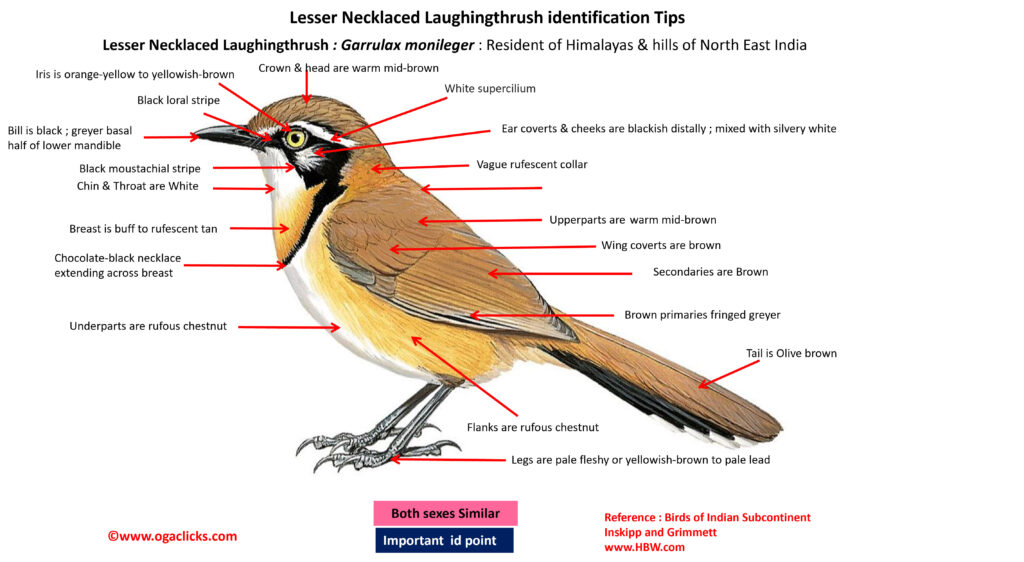
Lesser Necklaced Laughingthrush Garrulax monileger
Etymology
- Garrulax : Latin word garrulous –babbling, chattering; ax – inclining towards
- Monileger : Latin word monile – necklace, collar; ger – carrying { With a collar}
Vernacular Names: Ass: Poreri or Purirhi, Ben: Chhota penga, Lepcha: Ol-pho, Bhutia: Piang-kam
Sub Species:
- Nominate – Resident of North East Indian states (except East Arunachal Pradesh and adjacent North East Assam)
- m. badius– East & South East Arunachal Pradesh and Patkai Range, in East Assam { deeper-toned and darker-toned above than nominate, nuchal collar and flanks darker rufous}
Distribution in India:
- Nominate – Resident of North East Indian states (except East Arunachal Pradesh and adjacent North East Assam)
- m. badius– East & South East Arunachal Pradesh and Patkai Range, in East
Description: Size of 24–31·5 cm; wt. of 56–135 g. It is a large laughingthrush, brown, tan and white, with narrow blackish necklace from ear-coverts across breast and has pale eye. The nominate race has warm mid-brown crown and upperparts, with vague rufescent collar on nape and upper mantle. The wing fringes and central tail feathers are warm mid-brown, outer primaries are fringed greyer, outer tail feathers are blackish-brown distally with broad white tips; lores are buffish to above eye, narrow white supercilium behind eye to above rear ear-coverts, plush area around eye is black, ear-coverts are blackish distally but mixed with silvery white basally; lower submoustachial area is blackish but upper part is buffy white, chin and upper throat are buffy white, shading through buff to rufescent tan adjacent to variable-width chocolate-black necklace extending from lower rear ear-coverts across breast; rest of underparts are whitish or buffy white, flanks with dull rufous wash, undertail-coverts are mixed white and pale warm buff; iris is orange-yellow to yellowish-brown; bill is black or blackish-grey, often basal half of lower mandible is greyer; legs are pale fleshy or yellowish-brown to pale lead. Both the sexes are similar. The juvenile has upperparts more rufescent, gorget is weaker, mid-belly is buffier, outer webs of primaries are buffier, white on tail tips are reduced. The race badius is deeper-toned and darker-toned above than nominate, nuchal collar and flanks are darker rufous; race mouhoti is much whiter on upper flanks and belly, nuchal collar is somewhat less broad and slightly more chestnut.
Habitat: It is found in broadleaf evergreen and deciduous forest, secondary forest, scrub, hedgerows in more open areas. It is found from sea-level to 1675 m.
Food Habits: It eats insects and their larvae, like millers, ants, snails and small lizards and also berries, small fruits, seeds and green vegetable matter. It is highly gregarious, keeping in monospecific flocks outside breeding season, often in company with other laughingthrushes, including white-crested laughingthrush, greater necklaced laughingthrush and black-throated laughingthrush, where ranges overlap; also associates with Greater Racquet-tailed Drongo .It forages mostly on ground, hacking earth and tossing aside leaves, but moves through forest up to middle storey.
Breeding Habits: They Breed in Mar–Aug. They are multi-brooded. The nest is a broad, often shallow cup made of dry bamboo or other leaves, twigs, roots, creeper stems and tendrils, lined, sometimes thickly, with rootlets, black grass roots, leaf skeletons and fine twigs, placed above ground in bamboo or low tree. They lay a clutch 3–5eggs. Brood parasitism is done by Chestnut-winged Cuckoo and Jacobin Cuckoo.